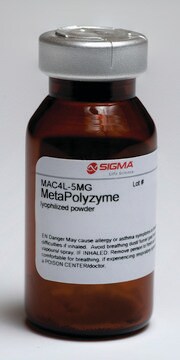SML2430
Kdo2-Lipid A (KLA)
≥90% (HPLC)
Sinonimo/i:
Di[3-deoxy-D-manno-octulosonyl]-lipid A (ammonium salt), KLA, Kdo2-LipidA
About This Item
Prodotti consigliati
Origine biologica
Escherichia coli
Saggio
≥90% (HPLC)
Forma fisica
solid
Temperatura di conservazione
−20°C
Stringa SMILE
O=C(O)[C@@]1(O[C@H]2[C@@H](O)C([C@H](O)CO)O[C@](C(O)=O)(OC[C@H]3O[C@@H](OC[C@H]4O[C@H](OP(O)(O)=O)[C@@H](NC(C[C@@H](CCCCCCCCCCC)O)=O)C(OC(C[C@@H](CCCCCCCCCCC)O)=O)[C@H]4O)C(NC(C[C@@H](CCCCCCCCCCC)OC(CCCCCCCCCCC)=O)=O)[C@@H](OC(C[C@@H](CCCCCCCCCCC)OC(CCCCC
Categorie correlate
Descrizione generale
Altre note
Codice della classe di stoccaggio
11 - Combustible Solids
Classe di pericolosità dell'acqua (WGK)
WGK 3
Punto d’infiammabilità (°F)
No data available
Punto d’infiammabilità (°C)
No data available
Certificati d'analisi (COA)
Cerca il Certificati d'analisi (COA) digitando il numero di lotto/batch corrispondente. I numeri di lotto o di batch sono stampati sull'etichetta dei prodotti dopo la parola ‘Lotto’ o ‘Batch’.
Possiedi già questo prodotto?
I documenti relativi ai prodotti acquistati recentemente sono disponibili nell’Archivio dei documenti.
I clienti hanno visto anche
Il team dei nostri ricercatori vanta grande esperienza in tutte le aree della ricerca quali Life Science, scienza dei materiali, sintesi chimica, cromatografia, discipline analitiche, ecc..
Contatta l'Assistenza Tecnica.








